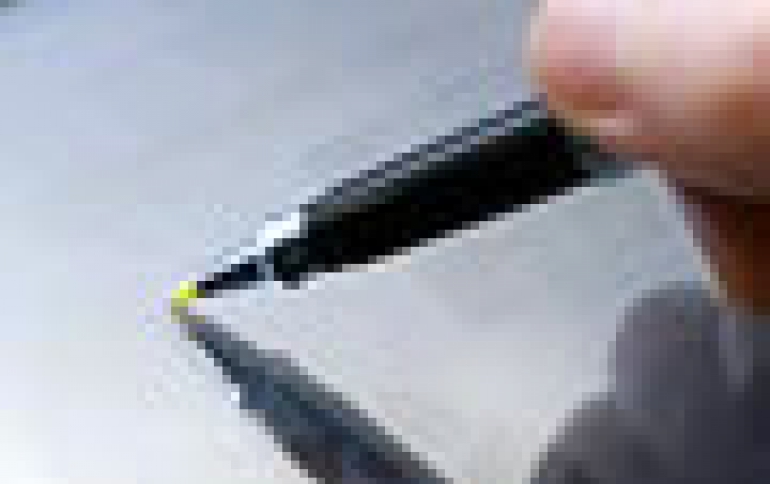
Microsoft Creates Stylus for Any Screen
A Microsoft research team has designed a stylus that could interact with almost any existing display or device.
The stylus concept allows precise stylus use on any display, even on those that aren't already touch-sensitive.
Andreas Nowatzyk and colleague Anoop Gupta hit upon the idea of using the grid of pixels that make up a digital display as a navigational system for their backwards-compatible stylus. In their design, a small camera inside the stylus looks down at the display and counts off pixels as they pass by to track its movement. That is fed back to the device via a wireless link, much as a wireless mouse reports its motion to a computer. The way the stylus tracks its motion is similar to the way "smart pens" such as the LiveScribe, a device for aiding note-taking, use a camera to track dots on special paper.
The new Microsoft design has the camera looking out of the side of the stylus body at an angle, so it views the display aslant. That lets it infer the angle it is being held at based on how different pixels are in and out of focus.
However, for the stylus to work, it also needs to know precisely where on the screen it is at any time. The Microsoft researchers' solution was to have the related software "massage" the color of the blue pixels in a display so that their pattern of brightness encodes their position; the stylus then knows where it is.
However, researchers would need a new type of image sensor to actually test prototypes. A good quality wireless mouse now uses a compact image sensor with a resolution of 30 by 30 pixels. To work, the new stylus design would require one with a resolution of 512 by 512 pixels to see the details as small as a tenth of a millimeter and to capture images at a relatively high rate to track motion smoothly. "The next step [in development] requires making that chip," Nowatzyk told MIT Technology Review. "It's currently being looked at in other groups inside Microsoft." He says that no decision has yet been made on whether to develop the design into a product or not.
Andreas Nowatzyk and colleague Anoop Gupta hit upon the idea of using the grid of pixels that make up a digital display as a navigational system for their backwards-compatible stylus. In their design, a small camera inside the stylus looks down at the display and counts off pixels as they pass by to track its movement. That is fed back to the device via a wireless link, much as a wireless mouse reports its motion to a computer. The way the stylus tracks its motion is similar to the way "smart pens" such as the LiveScribe, a device for aiding note-taking, use a camera to track dots on special paper.
The new Microsoft design has the camera looking out of the side of the stylus body at an angle, so it views the display aslant. That lets it infer the angle it is being held at based on how different pixels are in and out of focus.
However, for the stylus to work, it also needs to know precisely where on the screen it is at any time. The Microsoft researchers' solution was to have the related software "massage" the color of the blue pixels in a display so that their pattern of brightness encodes their position; the stylus then knows where it is.
However, researchers would need a new type of image sensor to actually test prototypes. A good quality wireless mouse now uses a compact image sensor with a resolution of 30 by 30 pixels. To work, the new stylus design would require one with a resolution of 512 by 512 pixels to see the details as small as a tenth of a millimeter and to capture images at a relatively high rate to track motion smoothly. "The next step [in development] requires making that chip," Nowatzyk told MIT Technology Review. "It's currently being looked at in other groups inside Microsoft." He says that no decision has yet been made on whether to develop the design into a product or not.





















